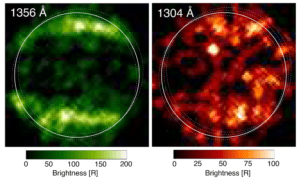Edinburgh, 28 July 2021. – Scientists compared archival data from NASA’s Hubble telescope from between 1998 and 2010 and the Cosmic Origins Spectrograph from 2018 and, for the first time, encountered evidence of water vapour in the thin atmosphere of the Solar System’s largest moon, Ganymede.

Previously, research has suggested the presence of molecular oxygen (O2) after auroral bands were discovered in the ultraviolet (UV) images produced by the Hubble Space Telescope, NASA said.
However, when comparing these to recent datasets, astronomers have discovered that there was almost no O2 in the atmosphere in 2018 implying another reason for the charged particle bands.
Taking a closer look, NASA scientists have discovered that these UV aurora bands coincided with equatorial regions of the icy moon where daytime surface temperatures at noon allowed for the ice to sublimate that is, turn from solid to gas, thus releasing water particles into the atmosphere.
NASA’s Juno mission has been taking a close look at Jupiter and its moons since 2016 and the European Space Agency (ESA) is launching JUICE (JUpiter ICy moons Explorer), its first large-class mission in 2022, with a planned arrival at Jupiter in 2029, to do further investigations on Ganymede, among other moons and Jupiter itself.
The three-year mission will explore Ganymede as a planetary body and a potential habitat with unique plasma and magnetic interactions with Jupiter which will help understand how giant gas planets and their moons form and evolve.
 SpaceWatch.Global An independent perspective on space
SpaceWatch.Global An independent perspective on space




